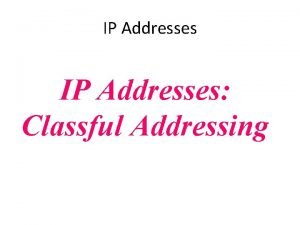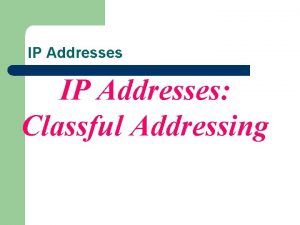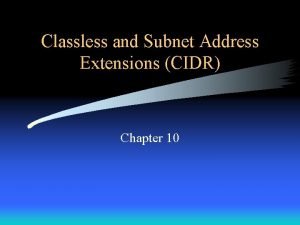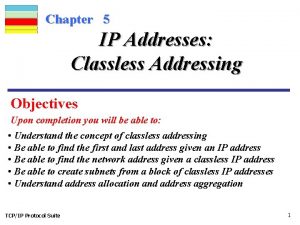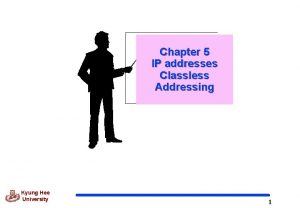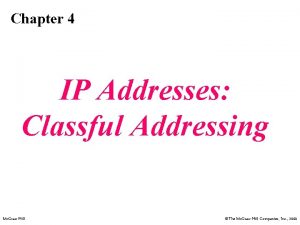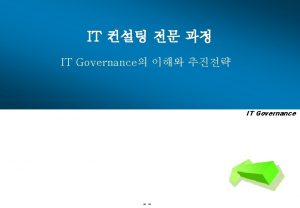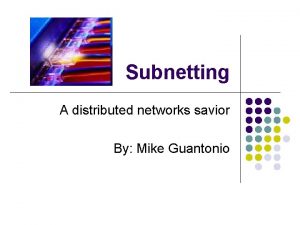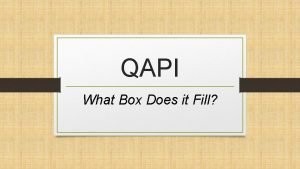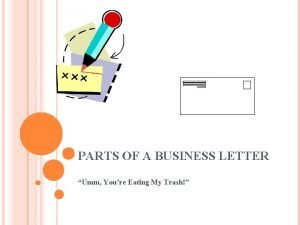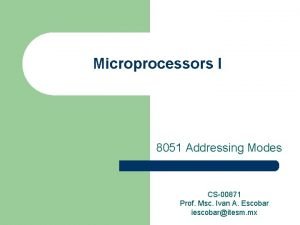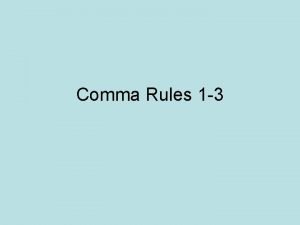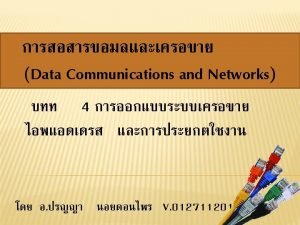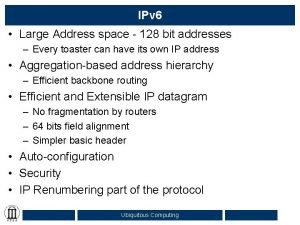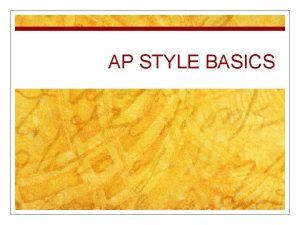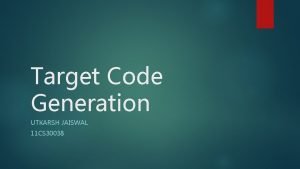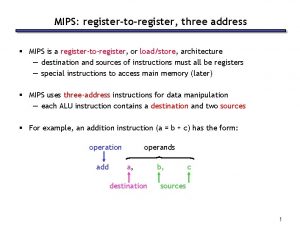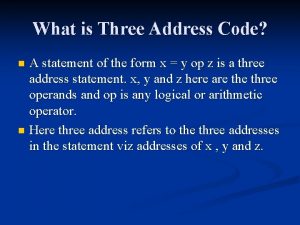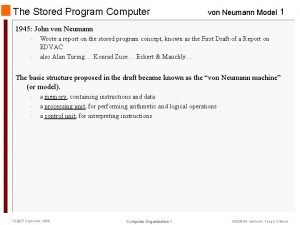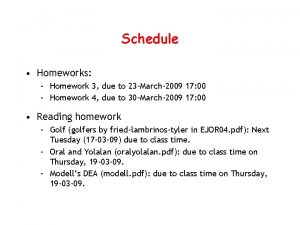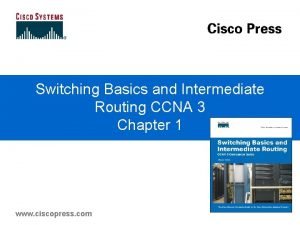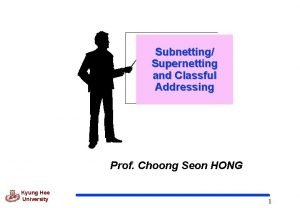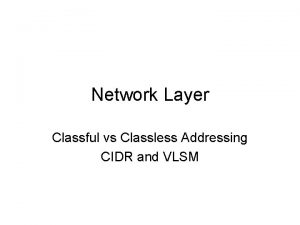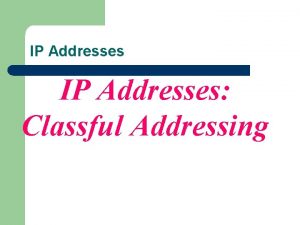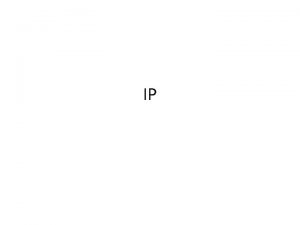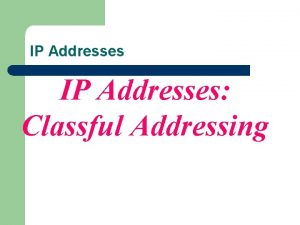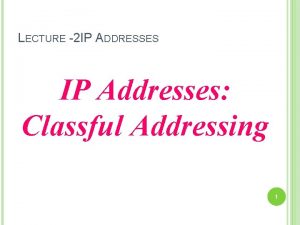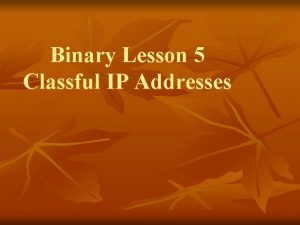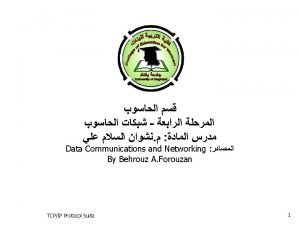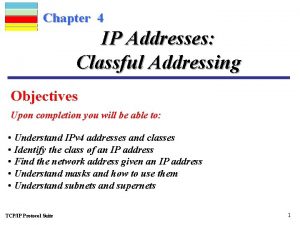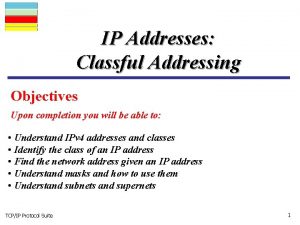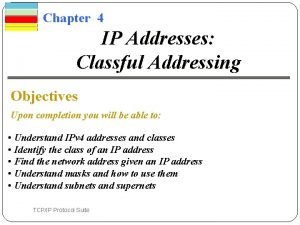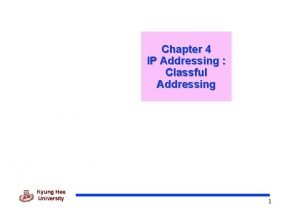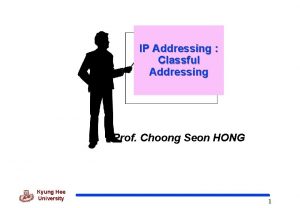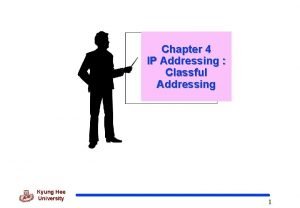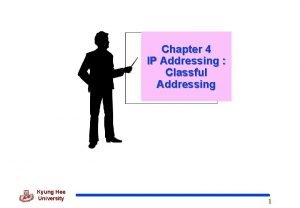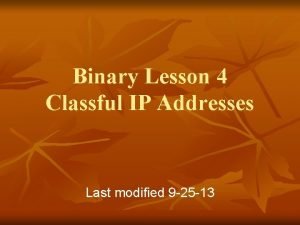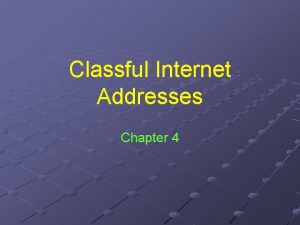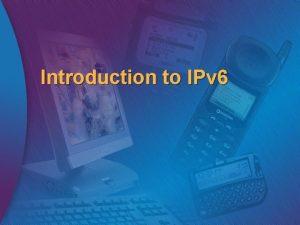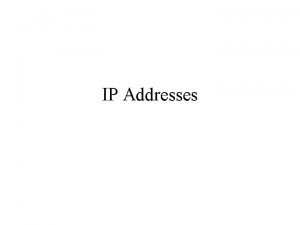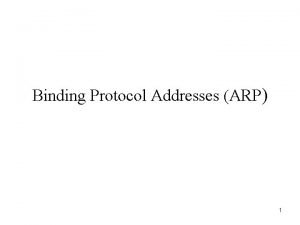IP Addresses Classful Addressing CONTENTS INTRODUCTION CLASSFUL ADDRESSING






































- Slides: 38

IP Addresses: Classful Addressing

CONTENTS • INTRODUCTION • CLASSFUL ADDRESSING • Different Network Classes • Subnetting • Classless Addressing • Supernetting • CIDR (classless Interdomain Routing)

4. 1 INTRODUCTION

What is an IP Address? An IP address is a 32 -bit address. The IP addresses are unique.

Address Space …………. . addr 15 addr 2 …………. . addr 41 addr 226 addr 31 …………. .

Address space rule …………. . addr 15 …………. . Theaddr 2 address space in a protocol …………. . That uses N-bits to define an addr 41 addr 226 Address is: addr 31 N …………. . 2 …………. .

IPv 4 address space The address space of IPv 4 is 232 or 4, 294, 967, 296.

Binary Notation 01110101 10010101 00011101010

Figure 4 -1 Dotted-decimal notation

Hexadecimal Notation 0111 0101 1001 0101 0001 1110 1010 75 95 1 D 0 x 75951 DEA EA

Example 1 Change the following IP address from binary notation to dotted-decimal notation. 10000001011 11101111 Solution 129. 11. 239

Example 2 Change the following IP address from dotted-decimal notation to binary notation: 111. 56. 45. 78 Solution 01101111 00111000 00101101 01001110

Example 3 Find the error in the following IP Address 111. 56. 045. 78 Solution There are no leading zeroes in Dotted-decimal notation (045)

Example 3 (continued) Find the error in the following IP Address 75. 45. 301. 14 Solution In decimal notation each number <= 255 301 is out of the range

Example 4 Change the following binary IP address Hexadecimal notation 10000001011 11101111 Solution 0 X 810 B 0 BEF or 810 B 0 BEF 16

CLASSFUL ADDRESSING

Figure 4 -2 Occupation of the address space

In classful addressing the address space is divided into 5 classes: A, B, C, D, and E.

Figure 4 -3 Finding the class in binary notation

Figure 4 -4 Finding the address class

Example 5 Show that Class A has 231 = 2, 147, 483, 648 addresses

Example 6 Find the class of the following IP addresses 00000001011 11101111 11000001011 11101111 Solution • 00000001011 11101111 1 st is 0, hence it is Class A • 11000001011 11101111 1 st and 2 nd bits are 1, and 3 rd bit is 0 hence, Class C

Figure 4 -5 Finding the class in decimal notation

Example 7 Find the class of the following addresses 158. 223. 1. 108 227. 13. 14. 88 Solution • 158. 223. 1. 108 1 st byte = 158 (128<158<191) class B • 227. 13. 14. 88 1 st byte = 227 (224<227<239) class D

IP address with appending port number • 158. 128. 1. 108: 25 • the for octet before colon is the IP address • The number of colon (25) is the port number

Figure 4 -6 Netid and hostid

Figure 4 -7 Blocks in class A

Millions of class A addresses are wasted.

Figure 4 -8 Blocks in class B

Many class B addresses are wasted.

Figure 4 -9 Blocks in class C

The number of addresses in a class C block is smaller than the needs of most organizations.

Class D addresses are used for multicasting; there is only one block in this class.

Class E addresses are reserved for special purposes; most of the block is wasted.

Network Addresses The network address is the first address. The network address defines the network to the rest of the Internet. Given the network address, we can find the class of the address, the block, and the range of the addresses in the block

In classful addressing, the network address (the first address in the block) is the one that is assigned to the organization.

Example 8 Given the network address 132. 21. 0. 0, find the class, the block, and the range of the addresses Solution The 1 st byte is between 128 and 191. Hence, Class B The block has a netid of 132. 21. The addresses range from 132. 21. 0. 0 to 132. 21. 255.

Default Mak • Class A default mask is 255. 0. 0. 0 • Class B default mask is 255. 0. 0 • Class C Default mask 255. 0
 Classful addressing example
Classful addressing example Classful and classless addressing
Classful and classless addressing Difference between classful and classless addressing
Difference between classful and classless addressing Difference between classful and classless addressing
Difference between classful and classless addressing Classless addressing example
Classless addressing example Classful addressing table
Classful addressing table Classful addressing example
Classful addressing example Flat addressing vs hierarchical addressing
Flat addressing vs hierarchical addressing Contents introduction
Contents introduction Are we running out of ip addresses
Are we running out of ip addresses Weak corrective action qapi
Weak corrective action qapi Basic parts of business letter
Basic parts of business letter 8051 addressing modes
8051 addressing modes Comma rule 1
Comma rule 1 Reserved ip addresses
Reserved ip addresses 128 bit address
128 bit address Datelines ap style
Datelines ap style Addresses in target code
Addresses in target code Mips register addresses
Mips register addresses Three addresses in three address code are
Three addresses in three address code are Modello von neumann
Modello von neumann (acv-s03) homework - addresses and references
(acv-s03) homework - addresses and references Classless and classful
Classless and classful Classful subnetting
Classful subnetting Classful vs classless
Classful vs classless Classful subnetting
Classful subnetting Classful subnetting
Classful subnetting Ip
Ip When organizing your career portfolio you should
When organizing your career portfolio you should Deep perineal pouch contents
Deep perineal pouch contents Febrile non hemolytic transfusion reaction
Febrile non hemolytic transfusion reaction Fresh frozen plasma contents
Fresh frozen plasma contents Posterior mediastinum
Posterior mediastinum Adductor (subsartorial) canal
Adductor (subsartorial) canal Level of the sternal angle
Level of the sternal angle The immortal life of henrietta lacks table of contents
The immortal life of henrietta lacks table of contents Medial lemniscus
Medial lemniscus Site:slidetodoc.com
Site:slidetodoc.com Ark of the covenant lampstand
Ark of the covenant lampstand
